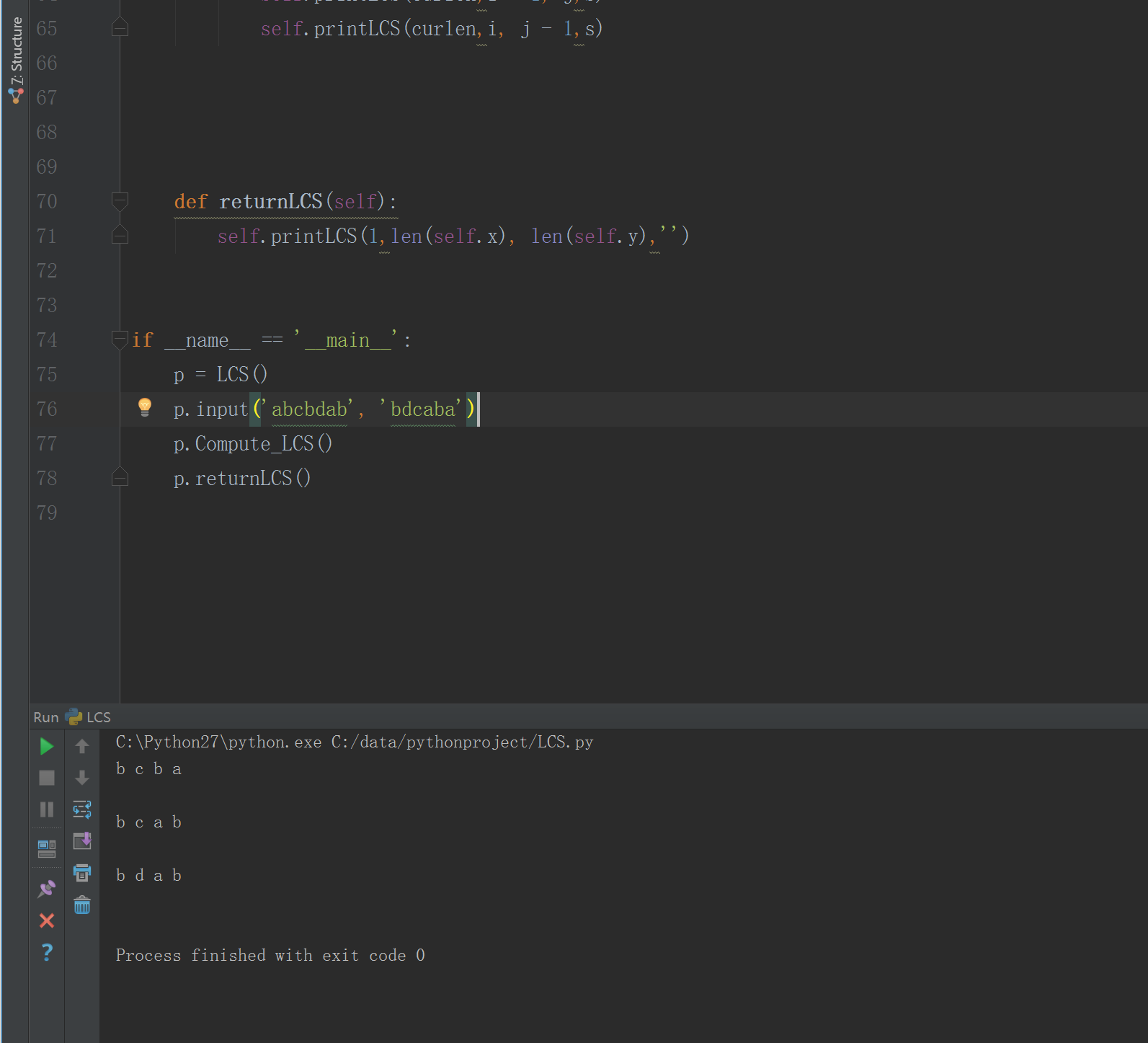1
2
3
4
5
6
7
8
9
10
11
12
13
14
15
16
17
18
19
20
21
22
23
24
25
26
27
28
29
30
31
32
33
34
35
36
37
38
39
40
41
42
43
44
45
46
47
48
49
50
51
52
53
54
55
56
57
58
59
60
61
62
63
64
65
66
67
68
69
70
71
72
73
74
75
76
77
78
| # coding=utf-8
class LCS():
def input(self, x, y):
#读入待匹配的两个字符串
if type(x) != str or type(y) != str:
print 'input error'
return None
self.x = x
self.y = y
def Compute_LCS(self):
xlength = len(self.x)
ylength = len(self.y)
self.direction_list = [None] * xlength #这个二维列表存着回溯方向
for i in xrange(xlength):
self.direction_list[i] = [None] * ylength
self.lcslength_list = [None] * (xlength + 1)
#这个二维列表存着当前最长公共子序列长度
for j in xrange(xlength + 1):
self.lcslength_list[j] = [None] * (ylength + 1)
for i in xrange(0, xlength + 1):
self.lcslength_list[i][0] = 0
for j in xrange(0, ylength + 1):
self.lcslength_list[0][j] = 0
#下面是进行回溯方向和长度表的赋值
for i in xrange(1, xlength + 1):
for j in xrange(1, ylength + 1):
if self.x[i - 1] == self.y[j - 1]:
self.lcslength_list[i][j] = self.lcslength_list[i - 1][j - 1] + 1
self.direction_list[i - 1][j - 1] = 0 # 左上
elif self.lcslength_list[i - 1][j] > self.lcslength_list[i][j - 1]:
self.lcslength_list[i][j] = self.lcslength_list[i - 1][j]
self.direction_list[i - 1][j - 1] = 1 # 上
elif self.lcslength_list[i - 1][j] < self.lcslength_list[i][j - 1]:
self.lcslength_list[i][j] = self.lcslength_list[i][j - 1]
self.direction_list[i - 1][j - 1] = -1 # 左
else:
self.lcslength_list[i][j] = self.lcslength_list[i - 1][j]
self.direction_list[i - 1][j - 1] = 2 # 左或上
self.lcslength = self.lcslength_list[-1][-1]
return self.direction_list, self.lcslength_list
def printLCS(self, curlen, i, j, s):
if i == 0 or j == 0:
return None
if self.direction_list[i - 1][j - 1] == 0:
if curlen == self.lcslength:
s += self.x[i - 1]
for i in range(len(s)-1,-1,-1):
print s[i],
print '\n'
elif curlen < self.lcslength:
s += self.x[i-1]
self.printLCS(curlen + 1, i - 1, j - 1, s)
elif self.direction_list[i - 1][j - 1] == 1:
self.printLCS(curlen,i - 1, j,s)
elif self.direction_list[i - 1][j - 1] == -1:
self.printLCS(curlen,i, j - 1,s)
else:
self.printLCS(curlen,i - 1, j,s)
self.printLCS(curlen,i, j - 1,s)
def returnLCS(self):
#回溯的入口
self.printLCS(1,len(self.x), len(self.y),'')
if __name__ == '__main__':
p = LCS()
p.input('abcbdab', 'bdcaba')
p.Compute_LCS()
p.returnLCS()
|
